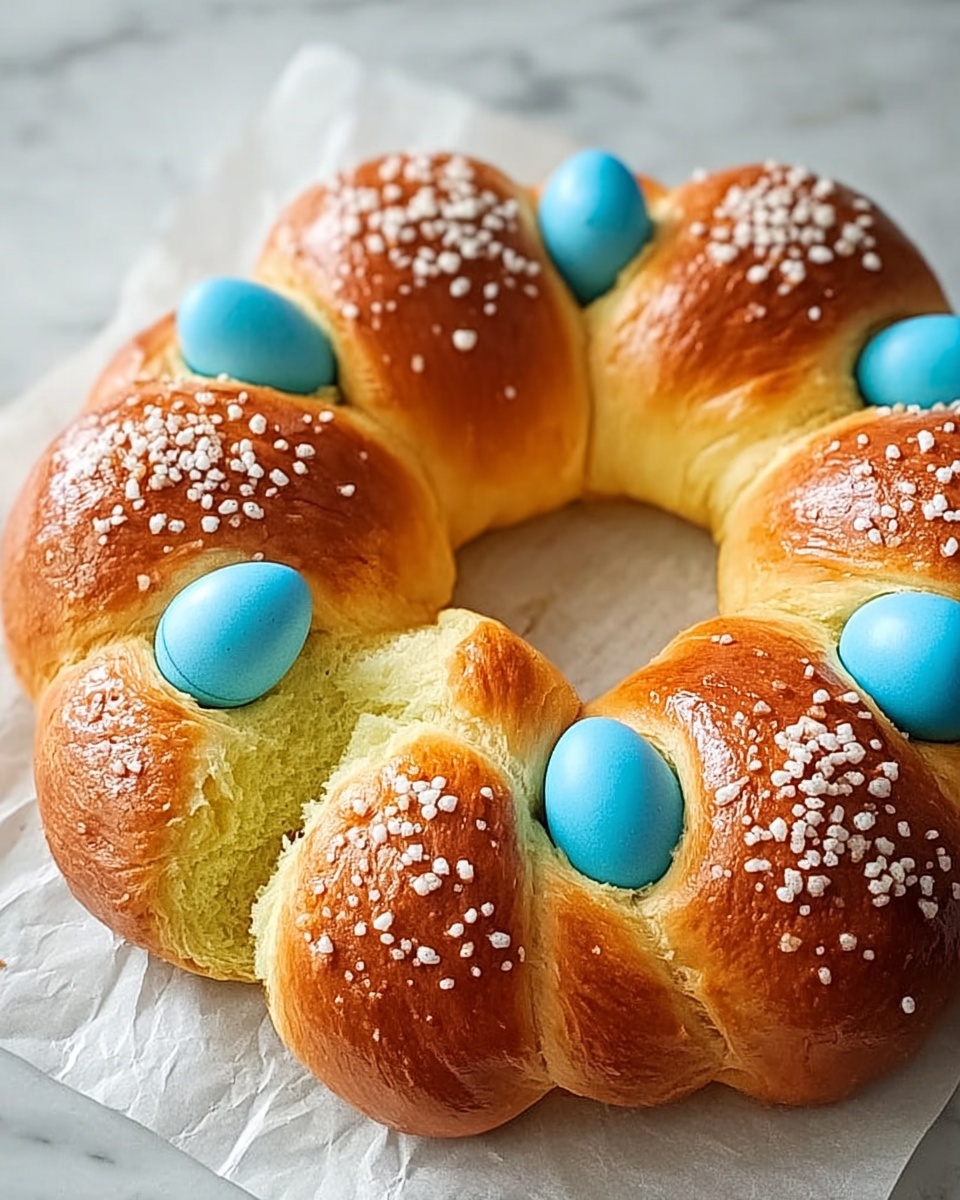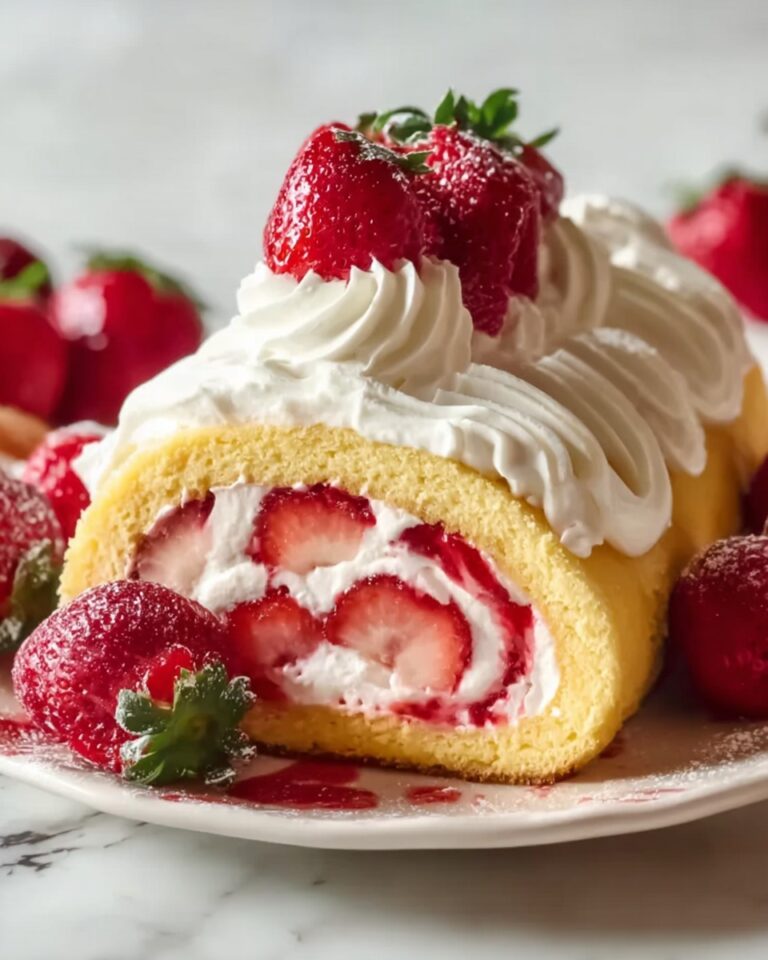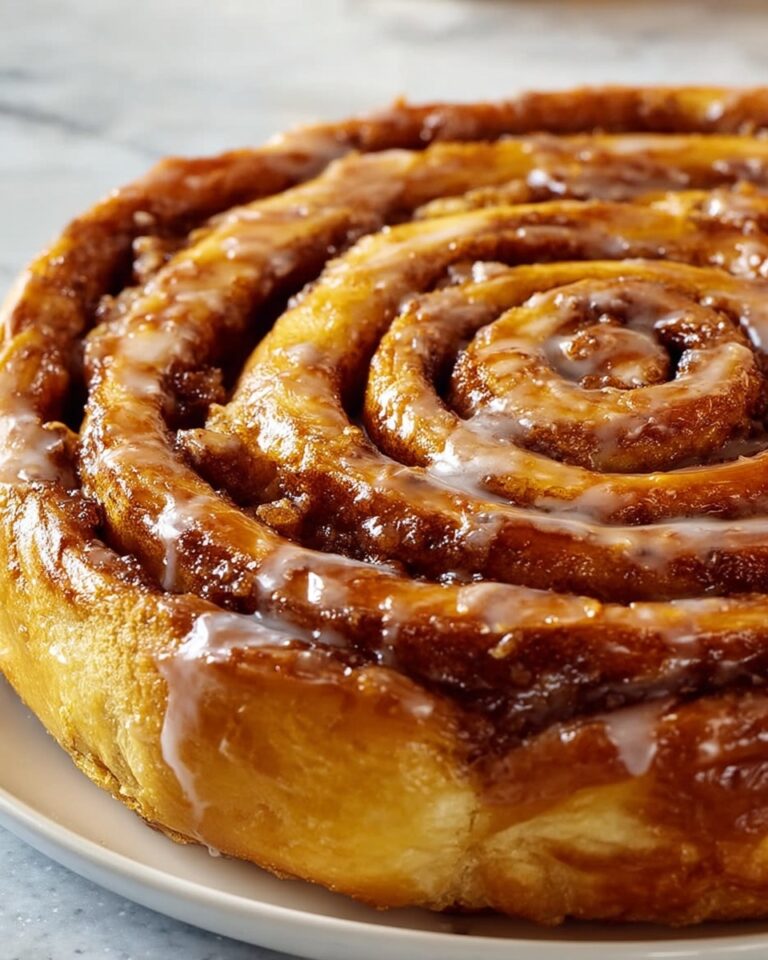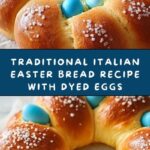If you’ve ever bitten into a slice of Italian Easter bread fresh from the oven, you know it is nothing short of magical. The perfect balance of soft, slightly sweet dough braided to perfection and nestled with colorful dyed eggs creates a centerpiece that feels like a warm hug from tradition itself. This Italian Easter Bread With Dyed Eggs Recipe is more than just a treat—it’s a celebration of family, heritage, and springtime joy wrapped into one irresistible loaf.
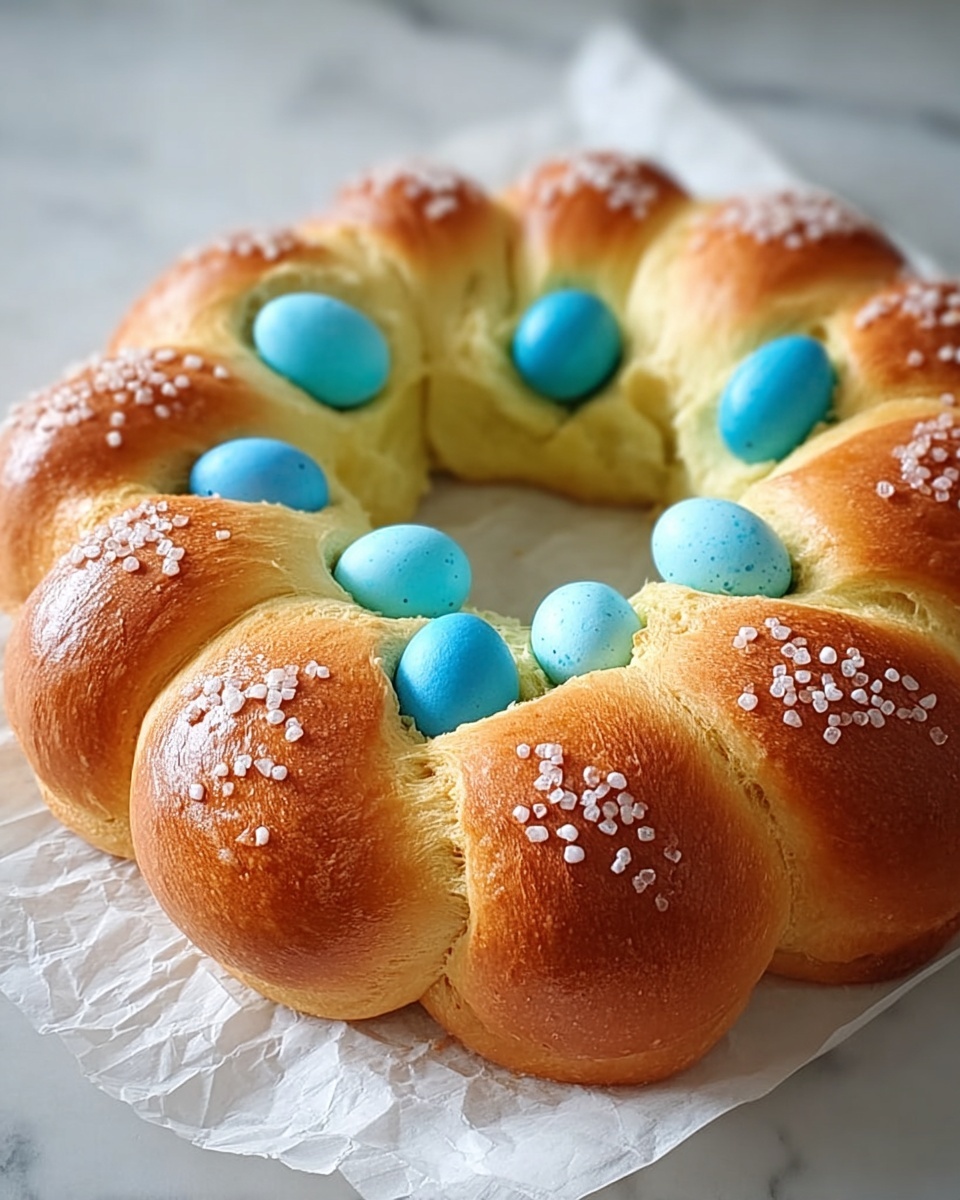
Ingredients You’ll Need
Getting to know the ingredients well is half the fun of any recipe, especially with a classic like this one. Each ingredient plays its role in building the bread’s soft texture, subtle sweetness, and vibrant look that makes it so special.
- 4 cups all-purpose flour: The foundation for the bread’s tender but sturdy crumb—plus, you’ll need a bit extra for kneading.
- 1/2 cup granulated sugar: Gives the bread a gentle sweetness that complements the eggs beautifully.
- 1 packet (2 1/4 teaspoons) active dry yeast: The magical leavening agent that makes the dough rise light and airy.
- 1 teaspoon salt: Balances the sweetness and enhances flavor overall.
- 1/2 cup milk, warmed to 110°F: Adds richness and moisture, helping the dough to be tender.
- 1/2 cup water, warmed to 110°F: Activates the yeast and hydrates the flour.
- 1/4 cup unsalted butter, softened: Contributes to tenderness and a melt-in-your-mouth texture.
- 2 large eggs: Bring richness and structure into the dough.
- 1 teaspoon vanilla extract: Adds a warm, fragrant note that elevates the flavor.
- 1 teaspoon orange zest (optional): A fresh citrus touch that brightens up the taste.
- 1/4 cup sugar (for sprinkling): For a sparkling finish on top of the loaf.
- 4-6 hard-boiled dyed eggs: The colorful Easter symbols thoughtfully tucked into the braid.
- 1 egg yolk (for egg wash): Brushed over the loaf to give it a gorgeous golden shine.
How to Make Italian Easter Bread With Dyed Eggs Recipe
Step 1: Prepare the Dough
Start by taking the warm milk and water and mixing them with a tablespoon of sugar in a large bowl. Sprinkle the yeast on top and let it rest for 5 to 10 minutes until it becomes frothy—this means your yeast is alive and kicking, ready to work its magic!
Step 2: Mix the Ingredients
In another large bowl, whisk together your flour, remaining sugar, and salt. Then add in the yeast mixture, softened butter, eggs, and vanilla extract. Stir everything until the dough starts coming together. This is where the lovely base for your bread begins to take shape.
Step 3: Knead the Dough
Turn the dough out onto a floured surface and knead it well for 5 to 8 minutes. The dough should become smooth and elastic—if it’s sticky, dust a little more flour. Once kneaded, place it in a greased bowl, cover it with a towel, and set it somewhere warm to rise until doubled in size, about 1 to 1.5 hours. This rise is crucial—it’s what gives the bread its soft and airy character.
Step 4: Shape the Bread
After the dough has risen, punch it down and divide it into three equal parts. Roll each into a rope about 12 to 15 inches long and braid them together. Form this braid into a circle and pinch the ends to seal it—a lovely wreath of dough ready for Easter decorating.
Step 5: Add the Dyed Eggs
Now for the fun and colorful part: gently press your dyed hard-boiled eggs into the braid. Whether you place them symmetrically or freestyle your pattern, make sure each egg sits firmly nestled in the dough so they don’t move during baking.
Step 6: Let the Dough Rise Again
Cover your beautiful braided loaf and let it rise for another 30 to 45 minutes. This second rise puffs up the dough and prepares it for baking, ensuring a light texture and the perfect golden crust.
Step 7: Prepare the Egg Wash and Bake
Whisk together the egg yolk with a tablespoon of water and brush it evenly over the loaf. This coating will give your bread that alluring golden color and slight sheen. Place the bread on a parchment-lined baking sheet and bake in a preheated 350°F oven for 25 to 30 minutes until golden and hollow-sounding when tapped underneath.
Step 8: Cool and Enjoy
Allow your Italian Easter Bread With Dyed Eggs Recipe to cool on a wire rack before slicing. The aroma will have your whole house smelling like a celebration, and the festive eggs make every slice a delight to see and taste.
How to Serve Italian Easter Bread With Dyed Eggs Recipe

Garnishes
A light dusting of powdered sugar or a sprinkle of colored sugar crystals can add extra sparkle and sweetness if you want to go the extra mile. Fresh edible flowers or sprigs of rosemary around the bread plate make it look spring-perfect.
Side Dishes
This bread is wonderful on its own or paired with a light omelet for a festive brunch. You can also serve it alongside fresh fruit, a mild cheese platter, or a drizzle of honey for a deliciously balanced meal.
Creative Ways to Present
Try placing the loaf on a rustic wooden board adorned with Easter grass or nestling it in a large decorative basket. For kids, serve slices with the dyed eggs separated and let them peel and enjoy as a fun surprise inside the bread.
Make Ahead and Storage
Storing Leftovers
Wrap leftover bread tightly in plastic wrap or place it in an airtight container to keep it fresh. It should stay soft and delicious for about 2 to 3 days at room temperature.
Freezing
If you want to save your bread for longer, you can freeze it. Wrap it thoroughly in plastic wrap and then in foil, and freeze for up to 2 months. When ready to enjoy, thaw overnight at room temperature.
Reheating
To refresh your bread’s soft texture, warm slices gently in a toaster oven or microwave for a few seconds. This will bring the fresh-baked taste and aroma back to life beautifully.
FAQs
Can I use regular white eggs instead of dyed ones?
Absolutely! The dyed eggs not only add a festive look but are fully edible and taste the same as regular hard-boiled eggs. Using plain white eggs is fine if you prefer a simpler presentation.
Is it necessary to let the dough rise twice?
Yes, the two rises help develop the dough’s texture and flavor. The first rise activates the yeast and lets the dough expand, while the second rise after shaping ensures a light and tender final bread.
Can I add flavors like cinnamon or anise to this bread?
Definitely! This recipe is versatile. Adding spices like cinnamon or anise can make the bread even more flavorful and aromatic, which is a lovely twist on the traditional version.
How do I dye the eggs safely?
Use food-safe egg dyes, either store-bought or natural options like beet juice or turmeric. Always boil and cool the eggs before dyeing, and dry them completely before placing in the dough.
Can I make smaller individual rolls instead of one big loaf?
For sure! Divide the dough into smaller portions, braid or twist each one, and tuck in a dyed egg before baking. They make adorable single servings perfect for gifts or a party.
Final Thoughts
Making this Italian Easter Bread With Dyed Eggs Recipe brings so much joy—not just because of its beautiful appearance, but because it carries the warmth of tradition into your home. Gathering around to share this bread creates memories and smiles that last well beyond Easter Sunday. I truly encourage you to give it a try. You’ll find it as rewarding to make as it is to eat!
Print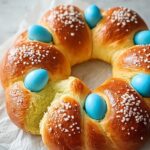
Italian Easter Bread With Dyed Eggs Recipe
- Prep Time: 30 minutes
- Cook Time: 30 minutes
- Total Time: 2 hours 15 minutes
- Yield: 1 loaf (serves about 8-10 slices)
- Category: Bread
- Method: Baking
- Cuisine: Italian
Description
This traditional Italian Easter Bread is a soft, sweet braided loaf decorated with pastel dyed hard-boiled eggs. Featuring a tender, slightly sweet dough flavored with vanilla and optional orange zest, this festive bread is perfect for celebrating Easter with family. The dough is enriched with butter and eggs, braided by hand, and baked to golden perfection, creating a beautiful centerpiece and delicious treat.
Ingredients
Dough Ingredients
- 4 cups all-purpose flour, plus extra for kneading
- 1/2 cup granulated sugar
- 1 packet (2 1/4 teaspoons) active dry yeast
- 1 teaspoon salt
- 1/2 cup milk, warmed to 110°F
- 1/2 cup water, warmed to 110°F
- 1/4 cup unsalted butter, softened
- 2 large eggs
- 1 teaspoon vanilla extract
- 1 teaspoon orange zest (optional, for flavor)
Decoration and Finishing
- 4–6 hard-boiled eggs (dyed in pastel colors for Easter)
- 1/4 cup sugar (for sprinkling)
- 1 egg yolk (for egg wash)
- 1 tablespoon water (for egg wash)
Instructions
- Prepare the Dough: In a large bowl, combine the warm milk, warm water, and 1 tablespoon of sugar. Sprinkle the yeast over the mixture and let it sit for about 5-10 minutes until it becomes frothy, indicating the yeast is active and ready.
- Mix the Ingredients: In a separate large bowl, whisk together the flour, remaining sugar, and salt. Add the yeast mixture, softened butter, eggs, vanilla extract, and optional orange zest. Mix everything until the dough begins to come together into a shaggy ball.
- Knead the Dough: Turn the dough onto a floured surface and knead for 5-8 minutes until it becomes smooth and elastic. If the dough is sticky, gradually add extra flour to manage stickiness. Place the dough in a greased bowl, cover with a clean towel, and let it rise in a warm place for 1 to 1.5 hours until doubled in size.
- Shape the Bread: Punch down the risen dough to release air. Divide it into three equal portions and roll each into a rope about 12-15 inches long. Braid the three ropes together tightly, then shape the braid into a circle and pinch the ends to seal the loaf.
- Add the Dyed Eggs: Gently press the pastel-colored hard-boiled eggs into the dough braid, distributing them evenly and securely. The eggs add a colorful, festive look intrinsic to this Easter tradition.
- Let the Dough Rise Again: Cover the braided loaf with a clean towel and allow it to rise again for 30-45 minutes, or until puffed and slightly expanded.
- Prepare the Egg Wash: In a small bowl, whisk together the egg yolk and 1 tablespoon water. Brush the entire surface of the loaf with this egg wash to promote a beautiful golden-brown crust during baking.
- Bake the Bread: Preheat the oven to 350°F (175°C). Place the loaf on a parchment-lined baking sheet and sprinkle with 1/4 cup sugar for added sweetness and texture. Bake for 25-30 minutes until the bread is golden brown and sounds hollow when tapped on the bottom, indicating it is fully baked.
- Cool and Serve: Transfer the bread to a wire rack and let it cool completely before slicing. Serve the bread with the decorative eggs, which can be eaten or preserved as a festive decoration.
Notes
- If you don’t have orange zest, the bread will still be delicious without it.
- Make sure the milk and water are warmed to about 110°F to activate the yeast but not so hot as to kill it.
- You can dye the eggs ahead of time using food coloring or natural dyes from vegetables.
- Use a kitchen towel to cover the dough during rising to maintain warmth and humidity.
- If the dough feels too sticky, add flour gradually but avoid adding too much to keep the bread light and tender.
- The sugar sprinkled on top before baking adds a lovely sparkle and subtle crunch.
- Store leftover bread wrapped in foil at room temperature for up to 2 days or freeze for longer storage.

